This article includes a list of general references, but it lacks sufficient corresponding inline citations .(June 2008) |


The Statue of Horatio Nelson, 1st Viscount Nelson, by Richard Westmacott stands in the Bull Ring, Birmingham, England.
This article includes a list of general references, but it lacks sufficient corresponding inline citations .(June 2008) |


The Statue of Horatio Nelson, 1st Viscount Nelson, by Richard Westmacott stands in the Bull Ring, Birmingham, England.
This bronze statue was the first publicly funded statue in Birmingham, and the first statue of Lord Nelson in Britain. It was made in 1809 by public subscription of £2,500 by the people of Birmingham following Nelson's visit to the town on 31 August 1802, the year before he sailed against the fleets of Napoleon. The statue was unveiled on 25 October 1809, that being the day decreed as the official Golden Jubilee of George III.

Nelson stands in uniform, with his one arm resting on an anchor with the prow of a miniature ship: HMS Victory. Upon the ship is the Flag Staff Truck (part of the mast) of the French ship Orient (1791), flagship of the French fleet, sunk at the Battle of the Nile. It originally stood on a cylindrical marble plinth carved with the people of Birmingham, surrounded by iron railings with lanterns standing on upended cannon at each corner.
The statue was originally erected on the site of the Old Cross, a two-storey building (a meeting hall over an open space), built in 1703 and demolished in August 1784. It stood outside the Market Hall (opened adjacent to it in 1835). Since 25 April 1952 it has had Grade II* listed status. [1]
A related statue was constructed in Bridgetown, Barbados, in 1813. Like the Birmingham statue, it was also sculpted by Westmacott, and based on the same design. [2]
The statue was moved in 1961 during the first redevelopment of the Bull Ring and the carved plinth, cannon and lanterns lost. After the recent redevelopment it has returned close to its original location north of the church. It stands on the high balcony between the Bullring shopping centre and the Selfridges store. Nelson now looks again over the church of St Martin in the Bull Ring. He now stands on a plain plinth, surrounded by iron railings linked by iron rope. These railings were the original railings, but were delayed from being installed by objections on the grounds of Health & Safety from the Bullring. However, the railings were restored in September 2005, just in time for the Trafalgar Bicentenary celebrations which centred on the statue.
The statue forms the centrepiece of Birmingham's annual Trafalgar Day commemoration.
In 2009, to mark the 200th anniversary of the statue's unveiling, a medal was struck by St Paul's Mint of Birmingham.

Trafalgar Square is a public square in the City of Westminster, Central London, established in the early 19th century around the area formerly known as Charing Cross. The square's name commemorates the Battle of Trafalgar, the British naval victory in the Napoleonic Wars over France and Spain that took place on 21 October 1805 off the coast of Cape Trafalgar.

The Bull Ring is a major shopping area in central Birmingham England, and has been an important feature of Birmingham since the Middle Ages, when its market was first held. Two shopping centres have been built in the area; in the 1960s, and then in 2003; the latter is styled as one word, Bullring. When coupled with Grand Central it forms the United Kingdom's largest city centre based shopping centre, styled as Bullring & Grand Central.

Nelson's Column is a monument in Trafalgar Square in the City of Westminster, Central London, built to commemorate Vice-Admiral Horatio Nelson's decisive victory at the Battle of Trafalgar over the combined French and Spanish navies, during which he was killed by a French sniper. The monument was constructed between 1840 and 1843 to a design by William Railton at a cost of £47,000. It is a column of the Corinthian order built from Dartmoor granite. The statue of Nelson was carved from Craigleith sandstone by sculptor Edward Hodges Baily. The four bronze lions around its base, designed by Sir Edwin Landseer, were added in 1867.

Boulton, Watt and Murdoch is a gilded bronze statue depicting Matthew Boulton, James Watt, and William Murdoch by William Bloye, assisted by Raymond Forbes Kings. It stands on a plinth of Portland stone in Centenary Square, Birmingham and marks the contribution these individuals made to the development of the steam engine and hence the start of the Industrial Revolution of the 18th century.
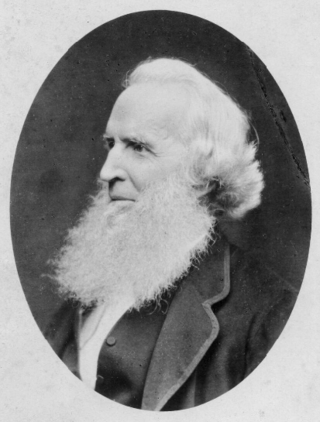
Sir Josiah Mason was an English industrialist, engaged in pen manufacture and other trades, and a philanthropist. He founded Mason Science College in 1875, which later became the University of Birmingham.
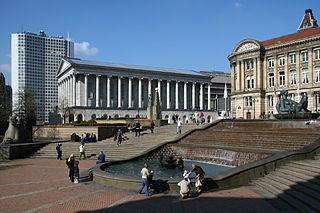
Victoria Square is a pedestrianised public square in Birmingham, England. It is home to both the Town Hall and the Council House, and directly adjacent to Chamberlain Square. It is named in honour of Queen Victoria.

The Nelson Memorial, Swarland is a white freestone obelisk at Swarland in north Northumberland, England. Erected in 1807, two years after the death of Horatio Nelson, 1st Viscount Nelson, victor of the Battle of Trafalgar, it was placed by his friend and sometime agent, Alexander Davison, who owned an estate centred on the now demolished Swarland Hall. It is a Grade II listed monument.

Trafalgar Day is the celebration of the victory won by the Royal Navy, commanded by Vice-Admiral Horatio Nelson, over the combined French and Spanish fleets at the Battle of Trafalgar on 21 October 1805.
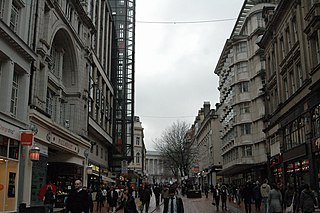
New Street is a street in central Birmingham, England. It is one of the city's principal thoroughfares and shopping streets linking Victoria Square to the Bullring Shopping Centre. It gives its name to New Street railway station, although the station has never had direct access to New Street except via Stephenson Place and latterly Grand Central shopping centre.
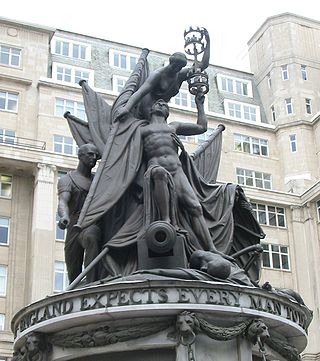
The Nelson Monument is a monument to Admiral Horatio Nelson, in Exchange Flags, Liverpool, England. It was designed by Matthew Cotes Wyatt and sculpted by Richard Westmacott. It stands to the north of the Town Hall and was unveiled in 1813.
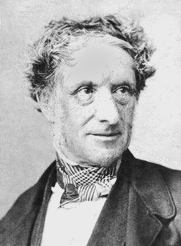
Sir Richard Westmacott was a British sculptor.
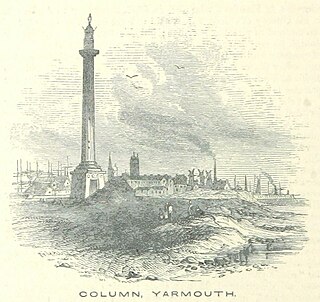
The Nelson's Monument is a commemorative column or tower built in memorial to Admiral Horatio Nelson, situated on the Denes, Great Yarmouth in the county of Norfolk, England. It was designated as a Grade I listed structure in 1953.

William Frederick Woodington was an English painter and sculptor.

Horatio Nelson, 1st Viscount Nelson (1758–1805) was a British flag officer in the Royal Navy famous for his participation in the Napoleonic Wars, most notably in the Battle of Trafalgar, during which he was killed. He was responsible for several famous victories that helped to secure British control of the seas, both securing Britain from French invasion and frustrating Napoleon's imperial ambitions. After his death during his defeat of the combined French and Spanish fleets at Trafalgar, there was a public outpouring of grief. Nelson was accorded a state funeral and was buried in St Paul's Cathedral.

Nelson's Column is a monument, designed by Scottish architect Robert Mitchell and erected in 1809 in Place Jacques-Cartier, Montreal, Quebec, Canada, which is dedicated to the memory of Admiral Horatio Nelson, following his death at the Battle of Trafalgar. Subsequent to the destruction of Nelson's Pillar in Dublin (1808–1966), Montreal's pillar now stands as the second-oldest "Nelson's Column" in the world, after the Nelson Monument in Glasgow. It is also the city's oldest monument and is the oldest war monument in Canada.

The Nelson Monument located within Glasgow Green is a commemorative obelisk built in honour of Vice Admiral Horatio Nelson, who had died at the Battle of Trafalgar on 21 October 1805. Funds of £2,075 were raised by subscription, and the foundation stone of the monument was laid with full ceremony on 1 August 1806, on the anniversary of the battle of Aboukir. The monument was finished on 7 August 1807, believed to be the first completed in the UK. It was decorated with four flags, a large crowd watched, and ships at the Broomielaw had their flags hoisted all day. A decision had not then been made on intended inscriptions.

The Collingwood Monument is a Grade II* listed monument in Tynemouth, England, dedicated to Vice Admiral Lord Cuthbert Collingwood. A Napoleonic-era admiral noted for being second-in-command to Admiral Lord Nelson during the Battle of Trafalgar, Collingwood is sometimes referred to as the forgotten hero of Trafalgar. The monument's base is by John Dobson and the statue is a work of the sculptor John Graham Lough. It is situated just off Front Street in Tynemouth and overlooks the mouth of the River Tyne.
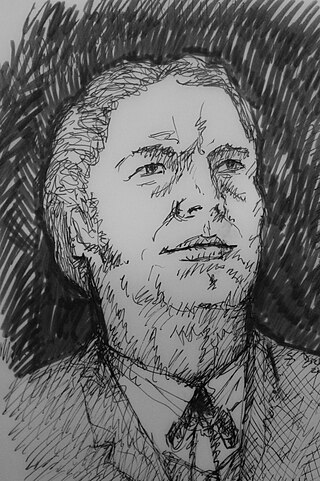
William Hollins was an 18th/19th century English architect and sculptor. His work is largely in the Greek Revival and Gothic styles.

A bronze statue of British naval officer Horatio Nelson, 1st Viscount Nelson was installed at National Heroes Square in Bridgetown, Barbados from 1813 to 2020. It has since been relocated to the Barbados Museum.